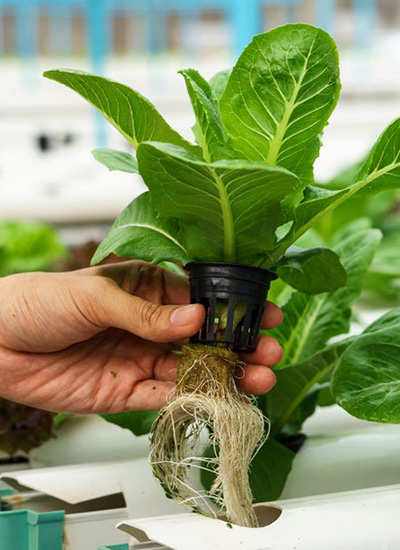

Aeroponics is the process of growing plants in an air or mist environment without the use of soil or an aggregate medium (known as geoponics). Aeroponic culture differs from both conventional hydroponics, aquaponics, and in-vitro (plant tissue culture) growing. Unlike hydroponics, which uses a liquid nutrient solution as a growing medium and essential minerals to sustain plant growth; or aquaponics which uses water and fish waste, aeroponics is conducted without a growing medium. Some advantages to using an aeroponic systems are they typically use little to no growing media. The roots get maximum oxygen, and the plants grow more rapidly as a result. Aeroponic systems also generally use less water than any other type of hydroponic system (especially true aeroponic systems). Also harvesting is usually easier, especially for root crops.
One of the primarily benefits of using aeroponics is that the plants receive more oxygen.
The exposed roots quickly absorb oxygen from the air, much faster than roots that are embedded in soil. Aeroponic plants and crops also tend to grow faster than those planted in soil, resulting in quicker harvests. One reason for the quicker growth is that more oxygen allows for the faster absorption of essential nutrients. Plants and crops, like humans, need certain nutrients to grow, especially nitrogen, phosphorus and potassium.
Low-Pressure Aeroponic (LPA) Systems :
LPA systems are often homemade backyard systems, which can also easily be found at your local grow supply store. This type of system can be very similar to a high-pressure aeroponics (HPA) system, however it would incorporate a simple water pump and larger spray nozzles to disperse the water. This ends up providing larger droplets of water than would be experienced with a HPA system which is one of the main reasons why they are not as efficient. LPA systems can also include top-feeding drippers or systems that allow the roots to grow into the nutrient solution. These types of systems are more commonly referred to as hybrid aeroponic/hydroponic systems or fake aeroponic grows. The simplicity and low cost are what make a LPA system appealing to growers.
High-Pressure Aeroponic Systems:
An HPA, or “true aeroponic grow system”, uses misting spray nozzles and high pressure pumps (around 60-120 psi) to properly atomize the water into a fine mist with a very small water droplet size. The mist allows the roots to get more oxygen than they would in a LPA system which is beneficial for plant growth. The droplets are in the 30-80 micron diameter range which is the “sweet spot” for maximum absorption by plant roots. HPA provides three benefits compared to conventional growing; the root mass is able to achieve a higher level of efficiency, it is possible to reduce nutrient use by 90%, and there is a lower rate of water use.